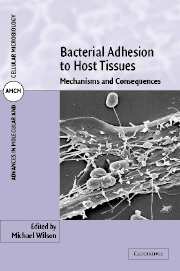Book contents
- Frontmatter
- Contents
- List of contributors
- Preface
- Part I Bacterial adhesins and adhesive structures
- 1 Surface protein adhesins of staphylococci
- 2 Mechanisms of utilization of host signalling molecules by respiratory mucosal pathogens
- 3 Adhesive surface structures of oral streptococci
- 4 Regulation and function of phase variation in Escherichia coli
- 5 Regulation of capsule expression
- 6 Role of pili in Haemophilus influenzae adherence, colonization and disease
- Part II Effect of adhesion on bacterial structure and function
- Part III Consequences of bacterial adhesion for the host
- Index
- Plate section
2 - Mechanisms of utilization of host signalling molecules by respiratory mucosal pathogens
Published online by Cambridge University Press: 08 October 2009
- Frontmatter
- Contents
- List of contributors
- Preface
- Part I Bacterial adhesins and adhesive structures
- 1 Surface protein adhesins of staphylococci
- 2 Mechanisms of utilization of host signalling molecules by respiratory mucosal pathogens
- 3 Adhesive surface structures of oral streptococci
- 4 Regulation and function of phase variation in Escherichia coli
- 5 Regulation of capsule expression
- 6 Role of pili in Haemophilus influenzae adherence, colonization and disease
- Part II Effect of adhesion on bacterial structure and function
- Part III Consequences of bacterial adhesion for the host
- Index
- Plate section
Summary
INTRODUCTION
Microbes such as Neisseria meningitidis (meningococcus) and Haemophilus influenzae that reside in a single niche, the human upper respiratory tract, are particularly adept at genotypic plasticity and generate phenotypic variants at high frequency. They elaborate multiple surface-expressed adhesive ligands, which undergo antigenic and phase variation with remarkable rapidity. Antigenic variation represents primary structural alteration, often arising from genetic rearrangements, and phase variation represents ‘on’ or ‘off’ mode of expression. The evolution of such variation as well as the redundancy in adhesins reflects the polymorphic nature of the host's immune response. The microbial counter-strategies accomplish not only immune evasion but also tissue tropism.
Multiple microbial adhesins may act individually or in concert to interact with target cell molecules, enabling the bacterium primarily to achieve the fundamental requirement of colonization, i.e. adherence to mucosa. Many of the target molecules are involved in normal cell–cell communications or in the reception of hormonal and other signals. As a result, targeting of these signalling molecules additionally allows bacteria to manipulate host cell functions, which may lead to intracellular location, transcytosis or paracytosis across the epithelial barrier. This chapter will outline some general mechanisms of host cell targeting that determine between adhesion and invasion. Further, it will describe several major surface structures of meningococci and their interplay in host cell recognition or evasion. Two specific receptor-targeting mechanisms are explored in detail, since they provide a paradigm to explain epidemiological evidence that implicates hostassociated factors in increased microbial invasion.
- Type
- Chapter
- Information
- Bacterial Adhesion to Host TissuesMechanisms and Consequences, pp. 27 - 58Publisher: Cambridge University PressPrint publication year: 2002
- 1
- Cited by

